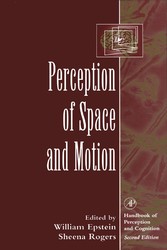Search and Find
Service
Front Cover
1
Perception of Space and Motion
4
Copyright Page
5
Contents
6
Contributors
14
Foreword
16
Preface
18
Chapter 1. The Metatheoretical Context
22
I. Introduction
22
II. The Inverse Projection Problem
22
III. Cues or Information
30
IV. Perceptual Constancy
35
V. Lessons from Illusions
37
VI. Alternative Investigative Prototypes
39
VII. Conclusion
41
References
41
Chapter 2. The Perception of Spatial Layout from Static Optical Information
44
I. Introduction
44
II. The Perception of Absolute Distance
46
III. The Perception of Relative Distance
61
IV. Surface Perception—Slant and Curvature
68
V. The Perception of Size and Shape
78
VI. Conclusion
82
References
82
Chapter 3. Perceiving Layout and Knowing Distances: The Integration, Relative Potency, and Contextual Use of Different Information about Depth*
90
I. On the Accuracy of Perceived Space
94
II. Information Integration: Rules, Weights, and the Feasibility of Complete Experimentation
96
III. Nine Sources of Information about Layout: Measurement, Assumptions, and Relative Efficacy
100
IV. A Situation-Sensitive Dominance Hierarchy
118
V. Three Applications for the System of Personal, Action, and Vista Spaces
124
VI. Conclusion
130
References
131
Chapter 4. Perceiving Pictorial Space
140
I. Introduction
140
II. Scaling Pictorial Space
144
III. Variables That Affect Perception of Pictorial Space
148
IV. The Problem of the Station Point
154
V. The Special Status of Pictures
178
VI. Conclusion
178
References
179
Chapter 5. Visible Information about Structure from Motion
186
I. Introduction: Changing Images and Visible Information
186
II. The Nature of Information
187
III. Image Information and the Spatial Structure of Images
193
IV. From Images to Perceptions of Moving Objects
209
V. Conclusion
216
References
217
Chapter 6. The Visual Perception of Three-Dimensional Structure from Motion
222
I. Optical Projection
223
II. Methodological Issues
226
III. General Factors That Can Affect Perceived Three-Dimensional Structure from Motion
228
IV. Theoretical Analyses
231
V. Empirical Tests of the Computational Models
234
VI. Problems for Future Research
238
References
242
Chapter 7. Perceiving Events
248
I. Principles of Perceptual Grouping: Absolute, Relative, and Common Motions
249
II. Perceiving Biomechanical Motions
255
III. Perceiving Approaching Objects
261
IV. Perceiving Natural Dynamics
271
V. Conclusion
277
References
277
Chapter 8. Sel Motion: Visual Perception and Visual Control
284
I. Introduction
284
II. Optic Flow
287
III. Visual Perception of Self-Motion
304
IV. Visual Control of Self-Motion
321
V. New Directions
331
References
333
Chapter 9. Ontogenesis of Space and Motion Perception
348
I. Introduction
348
II. Space: The First Frontier
349
III. Motion Perception
366
IV. Conclusion
376
References
379
Chapter 10. Auditory Spatial Layout
386
I. Introduction
386
II. Acoustical Information: The Ambient Sound Field and the Effective Stimulus
388
III. Auditory Objects
392
IV. Spatial Layout of Stationary Auditory Objects
393
V. Spatial Layout of Dynamic Auditory Objects
406
VI. The Role of Auditory-Visual Interactions in the Spatial Layout of Auditory Objects
415
VII. Conclusion
417
References
418
Chapter 11. Dynamic Touch
422
I. The Nature of Dynamic Touch
422
II. Dynamics of Wielding
425
III. Perceiving Object Length
428
IV. The Inertia Tensor Field and the Challenge of Perceiving a Constant Object Extent over Free Movements of a Multisegmented Limb
438
V. Perceiving Shape
441
VI. Perceiving Length under Conditions of Minimal Wielding
443
VII. Perceiving Hand–Object and Object–Hand Relations
449
VIII. Dynamic Touch and the "Muscular Sense"
458
IX. Perceiving Limb Position by Dynamic Touch
461
X. Weight Perception and the Size–Weight Illusion
469
XI. Selectively Perceiving Parts of an Object
473
XII. Perceiving Surface Layout and Hand-Held Probes by Probing
483
XlII. Distance Perception by Vibrations of Solid Media
495
XIV. Implications of Research on Dynamic Touch for Perception in General
498
XV. Concluding Remarks
504
References
505
Index
512
All prices incl. VAT











